Prediction of Steam Jacket Dynamics and Water Balances in Underground Coal Gasification
Abstract
:1. Introduction
2. Method and Numerical Model Description
3. Modeling Approach Validation Using UCG Trial Data
3.1. Field-Tests Hanna II and Hoe Creek II
3.2. Previous Existing Models to Quantify Water Balances
3.3. Numerical Model Implementation
3.4. Model Validation Results and Discussion
4. Effect of Reactor Pressure and Coal Seam Permeability on Steam Jacket Dynamics
4.1. Numerical Model Geometry, Initial and Boundary Conditions
4.2. Steam Jacket Dynamics in the UCG Reactor Vicinity
4.3. Pressure and Temperature Variation in the Overburden Aquifer
5. Discussion and Conclusions
Acknowledgments
Author Contributions
Conflicts of Interest
References
- Burton, E.; Friedmann, J.; Upadhye, R. Best Practices in Underground Coal Gasification; Contract No. W-7405-Eng-48; Lawrence Livermore National Laboratory: Livermore, CA, USA, 2006.
- Blinderman, M.S.; Saulov, D.N.; Klimenko, A.Y. Forward and reverse combustion linking in underground coal gasification. Energy 2008, 33, 446–454. [Google Scholar] [CrossRef]
- Couch, G. Underground Coal Gasification; CCC/151; IEA Clean Coal Centre: London, UK, 2009. [Google Scholar]
- Durucan, S.; Korre, A.; Shi, J.-Q.; Idiens, M.; Stańczyk, K.; Kapusta, K.; Rogut-Dabrowska, A.; Kempka, T.; Wolf, K.-H.; Younger, P.; et al. TOPS: Technology Options for Coupled Underground Coal Gasification and CO2 Capture and Storage. Energy Procedia 2014, 63, 5827–5835. [Google Scholar] [CrossRef]
- Nakaten, N.; Azzam, R.; Kempka, T. Sensitivity analysis on UCG–CCS economics. Int. J. Greenh. Gas Control 2014, 26, 51–60. [Google Scholar] [CrossRef]
- Kempka, T.; Fernández-Steeger, T.; Li, D.Y.; Schulten, M.; Schlüter, R.; Krooss, B.M. Carbon dioxide sorption capacities of coal gasification residues. Environ. Sci. Technol. 2011, 45, 1719–1723. [Google Scholar] [CrossRef] [PubMed]
- Nakaten, N.; Islam, R.; Kempka, T. Underground Coal Gasification with Extended CO2 Utilization—An Economic and Carbon Neutral Approach to Tackle Energy and Fertilizer Supply Shortages in Bangladesh. Energy Procedia 2014, 63, 8036–8043. [Google Scholar] [CrossRef]
- Nakaten, N.; Schlüter, R.; Azzam, R.; Kempka, T. Development of a techno-economic model for dynamic calculation of cost of electricity, energy demand and CO2 emissions of an integrated UCG–CCS process. Energy 2014, 66, 779–790. [Google Scholar] [CrossRef]
- Nakaten, N.; Kötting, P.; Azzam, R.; Kempka, T. Underground Coal Gasification and CO2 Storage Support Bulgaria’s Low Carbon Energy Supply. Energy Procedia 2013, 40, 212–221. [Google Scholar] [CrossRef]
- Humenick, M. Groundwater pollutants from underground coal gasification. Water Res. 1978, 12, 463–469. [Google Scholar] [CrossRef]
- Liu, S.; Li, J.; Mei, M.; Dong, D. Groundwater Pollution from Underground Coal Gasification. J. China Univ. Min. Technol. 2007, 17, 467–472. [Google Scholar] [CrossRef]
- Campbell, J.H.; Wang, F.T.; Mead, S.W.; Busby, J.F. Groundwater quality near an underground coal gasification experiment. J. Hydrol. 1979, 44, 241–266. [Google Scholar] [CrossRef]
- Kapusta, K.; Stańczyk, K.; Wiatowski, M.; Chećko, J. Environmental aspects of a field-scale underground coal gasification trial in a shallow coal seam at the Experimental Mine Barbara in Poland. Fuel 2013, 113, 196–208. [Google Scholar] [CrossRef]
- Camp, D.W.; White, J.A. Underground Coal Gasification: An Overview of Groundwater Contamination Hazards and Mitigation Strategies; Report No.: LLNL-TR-668633; Lawrence Livermore National Laboratory: Livermore, CA, USA, 2015.
- Klebingat, S.; Kempka, T.; Schulten, M.; Azzam, R.; Fernandez-Steeger, T.M. Innovative thermodynamic underground coal gasification model for coupled synthesis gas quality and tar production analyses. Fuel 2016, 183, 680–686. [Google Scholar] [CrossRef]
- Akbarzadeh Kasani, H.; Chalaturnyk, R.J. Coupled reservoir and geomechanical simulation for a deep underground coal gasification project. J. Nat. Gas Sci. Eng. 2017, 37, 487–501. [Google Scholar] [CrossRef]
- Buscheck, T.; Hao, Y.; Morris, J.P.; Burton, E. Thermal-Hydrological Sensitivity Analysis of Underground Coal Gasification. In Proceedings of the 2009 International Pittsburgh Coal Conference, Pittsburgh PA, USA, 5–8 October 2009; p. 8. [Google Scholar]
- Najafi, M.; Jalali, S.M.E.; KhaloKakaie, R.; Forouhandeh, F. Prediction of cavity growth rate during underground coal gasification using multiple regression analysis. Int. J. Coal Sci. Technol. 2015, 2, 318–324. [Google Scholar] [CrossRef]
- Otto, C.; Kempka, T. Thermo-Mechanical Simulations of Rock Behavior in Underground Coal Gasification Show Negligible Impact of Temperature-Dependent Parameters on Permeability Changes. Energies 2015, 8, 5800–5827. [Google Scholar] [CrossRef]
- Sury, M.; White, M.; Kirton, J.; Carr, P.; Woodbridge, R. Review of Environmental Issues of Underground Coal Gasification; Report No.: COAL R272 DTI/Pub URN 04/1880WS; Atkins Consultants Ltd.: Surrey, UK; University of Liège Belgium: Liège, Belgium; FWS Consultants Ltd.: Spennymoor, UK, 2004; pp. 1–126. [Google Scholar]
- Sarraf Shirazi, A.; Karimipour, S.; Gupta, R. Numerical Simulation and Evaluation of Cavity Growth in In Situ Coal Gasification. Ind. Eng. Chem. Res. 2013, 52, 11712–11722. [Google Scholar] [CrossRef]
- Morris, J.; Buscheck, T.; Hao, Y. Coupled Geomechanical Simulations of UCG Cavity Evolution. In Proceedings of the 2009 International Pittsburgh Coal Conference, Pittsburgh, PA, USA, 20–23 September 2009; p. 11. [Google Scholar]
- Otto, C.; Kempka, T. Thermo-mechanical Simulations Confirm: Temperature-dependent Mudrock Properties are Nice to have in Far-field Environmental Assessments of Underground Coal Gasification. Energy Procedia 2015, 76, 582–591. [Google Scholar] [CrossRef]
- Otto, C.; Kempka, T.; Kapusta, K.; Stańczyk, K. Fault Reactivation Can Generate Hydraulic Short Circuits in Underground Coal Gasification—New Insights from Regional-Scale Thermo-Mechanical 3D Modeling. Minerals 2016, 6, 101. [Google Scholar] [CrossRef]
- Akbarzadeh, H.; Chalaturnyk, R.J. Structural changes in coal at elevated temperature pertinent to underground coal gasification: A review. Int. J. Coal Geol. 2014, 131, 126–146. [Google Scholar] [CrossRef]
- Akbarzadeh, H.; Chalaturnyk, R.J. Coupled Fluid-Thermal-Mechanical Analyses of a Deep Underground Coal Gasification Cavity. Quest J. J. Archit. Civ. Eng. 2013, 1, 1–14. [Google Scholar]
- Krantz, W.B.; Camp, D.W.; Gunn, R.D. A Water-Influx Model for UCG. In Proceedings of the Sixth Underground Coal Conversion Symposium, Afton, OK, USA, 13–17 July 1980; pp. 21–31. [Google Scholar]
- Shafirovich, E.; Varma, A. Underground Coal Gasification: A Brief Review of Current Status. Ind. Eng. Chem. Res. 2009, 35, 7865–7875. [Google Scholar] [CrossRef]
- Saulov, D.N.; Plumb, O.A.; Klimenko, A.Y. Flame propagation in a gasification channel. Energy 2010, 35, 1264–1273. [Google Scholar] [CrossRef]
- Blinderman, M.S.; Jones, R.M. The Chinchilla IGCC Project to Date: Underground Coal Gasification and Environment. Proceedings of Gasification Technologies Conference, San Francisco, CA, USA, 27–30 October 2002. [Google Scholar]
- Perkins, G.; Love, G. Commercialisation of Underground Coal Gasification. In Proceedings of the Chemeca 2010: Engineering at the Edge Conference, Adelaide, Australia, 26–29 September 2010; p. 12. [Google Scholar]
- McKee, C.R.; Santoro, R.D. Gas Leakage and Water Influx from In Situ Coal Gasification; Report No. DE-AP-20-80-LC00193; Department of Energy, Laramie Energy Technology Center: Laramie, WY, USA, 1980. [Google Scholar]
- Nitao, J.J.; Camp, D.W.; Buscheck, T.A.; White, J.A.; Burton, G.C.; Wagoner, J.L.; Chen, M. Progress on a New Integrated 3-D UCG Simulator and its Initial Application. In Proceedings of the International Pittsburgh Coal Conference, Pittsburgh, PA, USA, 12–15 September 2011; p. 13. [Google Scholar]
- Akbarzadeh, H.; Chalaturnyk, R.J. Sequentially coupled flow-geomechanical modeling of underground coal gasification for a three-dimensional problem. Mitig. Adapt. Strateg. Glob. Chang. 2014, 21, 577–594. [Google Scholar] [CrossRef]
- Sarhosis, V.; Yang, D.; Sheng, Y.; Kempka, T. Coupled Hydro-thermal Analysis of Underground Coal Gasification Reactor Cool Down for Subsequent CO2 Storage. Energy Procedia 2013, 40, 428–436. [Google Scholar] [CrossRef]
- Yang, D.; Koukouzas, N.; Green, M.; Sheng, Y. Recent development on underground coal gasification and subsequent CO2 storage. J. Energy Inst. 2016, 89, 469–484. [Google Scholar] [CrossRef]
- Khan, M.; Mmbaga, J.; Shirazi, A.; Trivedi, J.; Liu, Q.; Gupta, R. Modelling Underground Coal Gasification—A Review. Energies 2015, 8, 12603–12668. [Google Scholar] [CrossRef]
- Afanasyev, A.A. Application of the reservoir simulator MUFITS for 3D modlling of CO2 Storage in geological formations. Energy Procedia 2013, 40, 365–374. [Google Scholar] [CrossRef]
- Afanasyev, A.A. Hydrodynamic Modelling of Petroleum Reservoirs using Simulator MUFITS. Energy Procedia 2015, 76, 427–435. [Google Scholar] [CrossRef]
- Afanasyev, A.A.; Kempka, T.; Kühn, M.; Melnik, O. Validation of the MUFITS Reservoir Simulator Against Standard CO2 Storage Benchmarks and History-matched Models of the Ketzin Pilot Site. Energy Procedia 2016, 97, 395–402. [Google Scholar] [CrossRef]
- Afanasyev, A.A. Simulation of the properties of a binary carbon dioxide-water mixture under sub- and supercritical conditions. High Temp. 2012, 50, 340–347. [Google Scholar] [CrossRef]
- Afanasyev, A.A. Multiphase compositional modelling of CO2 injection under subcritical conditions: The impact of dissolution and phase transitions between liquid and gaseous CO2 on reservoir temperature. Int. J. Greenh. Gas Control 2013, 19, 731–742. [Google Scholar] [CrossRef]
- Afanasyev, A.A.; Costa, A.A.; Chiodini, G. Investigation of hydrothermal activity at Campi Flegrei caldera using 3D numerical simulations: Extension to high temperature processes. J. Volcanol. Geotherm. Res. 2015, 299, 68–77. [Google Scholar] [CrossRef]
- Thorsness, C.B.; Cena, R.J. A UCG Process Data Base—Hoe Creek; Lawrence Livermore National Laboratory, Report No.: UCRL-84086; Lawrence Livermore National Laboratory: Berkeley, CA, USA, 1985.
- Bartke, T.C.; Fischer, D.D.; King, S.B.; Boyd, R.M.; Humphrey, A.E. Volume 1: General Information and Executive Summary. In Hanna, Wyoming Underground Coal Gasification Data Base; Morgantown Energy Technology Center and United States, Department of Energy, Office of Scientific and Technical Information: Laramie, WY, USA; 1985; p. 53. [Google Scholar]
- Barbour, F.A.; Covell, J.R. Trace Gas, Product Water, and Particulate Characterization for Rocky Mountain 1 UCG Project. In Underground Coal Gasification Test Hanna, Wyoming; Western Research Institute, University of Wyoming Research Corporation: Laramie, WY, USA, 1988; p. 105. [Google Scholar]
- Aiman, W.R.; Thorsness, C.B.; Hill, R.W.; Rozsa, R.B.; Cena, R.; Gregg, D.W.; Stephens, D.R. The Hoe Creek II Field Experiment On Underground Coal Gasification, Preliminary Results. In Proceedings of the Combustion Institute/Western States Section, Spring Meeting, Boulder, CO, USA, 17–18 April 1978; pp. 1–6. [Google Scholar]
- Campbell, G.G.; Brandenburg, C.F.; Boyd, R.M.; Sterner, T.E. Underground Coal Gasification at Hanna, Wyoming. In Proceedings of the Thermal Power Conference, Pullman, WA, USA, 15–17 October 1975; Laramie Aramie Energy Research Center Laramie: Laramie, WY, USA, 1975; p. 22. [Google Scholar]
- Fischer, D.D.; King, S.B.; Humphrey, A.E. A Report on the Successful Development of Underground Coal Gasification at Hanna, Wyoming; Energy Research and Development Administration, Laramie Energy Research Center: Laramie, WY, USA, 1975. [Google Scholar]
- Brandenburg, C.F.; Fischer, D.D.; Boyd, R.M.; King, S.B.; Humphrey, A.E. A review of LERC’s in situ coal gasification project. In Proceedings of the 3rd Annual UCC Symposium, South Lake Tahoe, CA, USA, 6–9 June 1977; pp. 66–76. [Google Scholar]
- Gunn, R.D.; Krantz, W.B. Underground Coal Gasification: Development of Theory, Laboratory Experimentation, Interpretation and Correlation with the Hanna Field Tests; Final Report: DE-AS20-80LC 10442; Department of Energy Office of Fossil Energy Morgantown Energy Technology Center: Morgantown, WV, USA, 1987. [Google Scholar]
- Bartke, T.C.; Fischer, D.D.; King, S.B.; Boyd, R.M.; Humphrey, A.E. Volume 3: The Hanna II, Phase I Field Test. In Hanna, Wyoming Underground Coal Gasification Data Base; Morgantown Energy Technology Center and United States, Department of Energy, Office of Scientific and Technical Information: Laramie, WY, USA, 1985; p. 52. [Google Scholar]
- LaFleur, D.W.; Grisak, G.E.; Stetzenbach, K.J.; Thompson, G.M. Evaluation of the Porosity of the Hanna No. 1 Coal Seam; Final Report: DE-AS2D-83LC10987; Department of Energy Laramie Energy Technology Center: Laramie, WY, USA, 1984. [Google Scholar]
- Nordin, J.S. Review of Information and Data Relevant to the Hoe Creek Underground Coal Gasification Site Restoration. In Western Research Institute, the University of Wyoming Research Coporation; Western Research Institute, The University of Wyoming Research Corporation: Laramine, WY, USA, 1992; Volume WRI-92-R01, p. 68. [Google Scholar]
- Camp, D.W. A model of Water Influx for Underground Coal Gasification. Master’s Thesis, University of Colorado, Boulder, CO, USA, 1980. [Google Scholar]
- Camp, D.W.; Krantz, W.B.; Gunn, R.D. A Water-Influx Model for UCG with Spalling-Enhanced Drying. In Proceedings of the 15th Intersociety Energy Conversion Engineering Conference, Seattle, WA, USA, 18–22 August 1980; p. 8. [Google Scholar]
- Levie, B.E.; Krantz, W.B.; Camp, D.W.; Gunn, R.D. Application of the Spalling-Enhanced-Drying Model in Predicting Cavity Geometry and Operating Strategy for the Hanna 2, Phase 2 UCG Field Test. In Proceedings of the Seventh Annual Underground Coal Conversion Symposium, Fallen Leaf Lake, CA, USA, 8–11 September 1980. [Google Scholar]
- Bartke, T.C.; Fischer, D.D.; King, S.B.; Boyd, R.M.; Humphrey, A.E. Volume 4: The Hanna II, Phase II and III Field Test. In Hanna, Wyoming Underground Coal Gasification Data Base; Morgantown Energy Technology Center and United States, Department of Energy, Office of Scientific and Technical Information: Laramie, WY, USA, 1985; p. 62. [Google Scholar]
- Boysen, J.E. Daily Material and Energy Balances for the Hanna Field Tests; Report: LETC Internal Document; Department of Energy Laramie Energy Technology Center: Laramie, WY, USA, 1978. [Google Scholar]
- Gunn, R.D. Material Balance: Its Applications and Mis-applications in Underground Coal Gasification; Report, LETC/RI-79105; Laramie Energy Technology Center: Laramie, WY, USA, 1979. [Google Scholar]
- Min, O.K. Finite Element Modeling of Thermo-Mechanical Responses Associated with Underground Coal Conversion. Ph.D. Thesis, Ohio State University, Columbus, OH, USA, 1983. [Google Scholar]
- Pakala, V.K.C. Evaporation Fronts in Porous Media. Ph.D. Thesis, Department of Mechanical Engineering, University of Wyoming, Laramie, WY, USA, 2012. [Google Scholar]
- Catton, H.; Lee, S. Two-Phase Flow in Porous Medium. In Proceedings of the ASME/JSME Thermal Engineering Joint Conference, Honolulu, HI, USA, 22–27 March 1987; Marto, P.J., Tanasawa, I., Eds.; Volume 2, pp. 333–341. [Google Scholar]
- Plumb, O.A.; Klimenko, A.Y. The Stability of Evaporating Fronts in Porous Media. J. Porous Media 2010, 13, 145–155. [Google Scholar] [CrossRef]
- Zhang, J.; Feng, Q.; Zhang, X.; Wen, S.; Zhai, Y. Relative Permeability of Coal: A Review. Transp. Porous Media 2015, 106, 563–594. [Google Scholar] [CrossRef]
- Lee, S.C. Computational Method for Thermoviscoelasticity with Application to Rock Mechanics. Ph.D. Thesis, Ohio State University, Columbus, OH, USA, 1984. [Google Scholar]
- Stone, R.; Snoeberger, D.F. Evaluation of the Native Hydraulic Characteristics of the Felix Coal (Eocene, Wasatch Formation) and Associated Strata, Hoe Creek Site, Campbell County, Wyoming; Report: UCRL-51992; Lawrence Livermore Laboratory: Livermore, CA, USA, 1976. [Google Scholar]
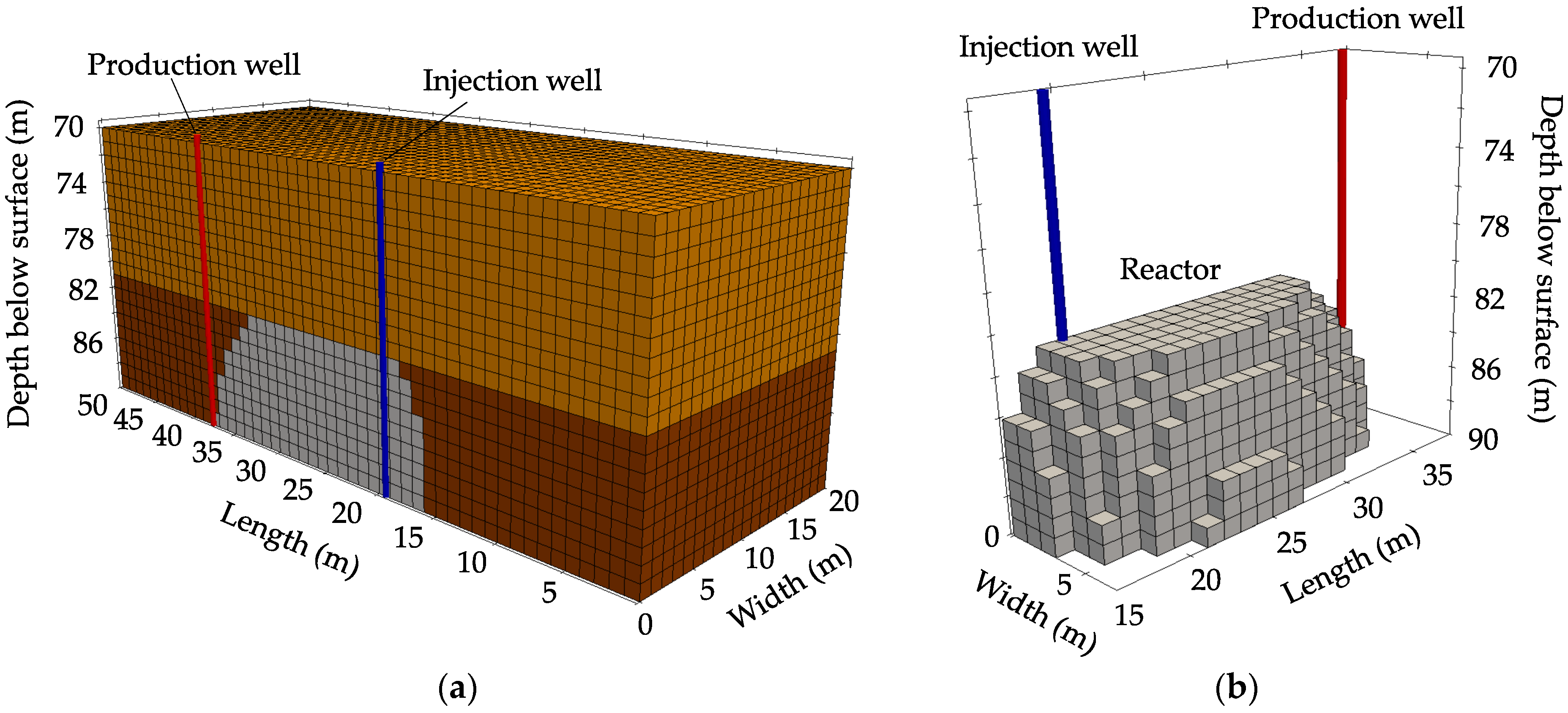
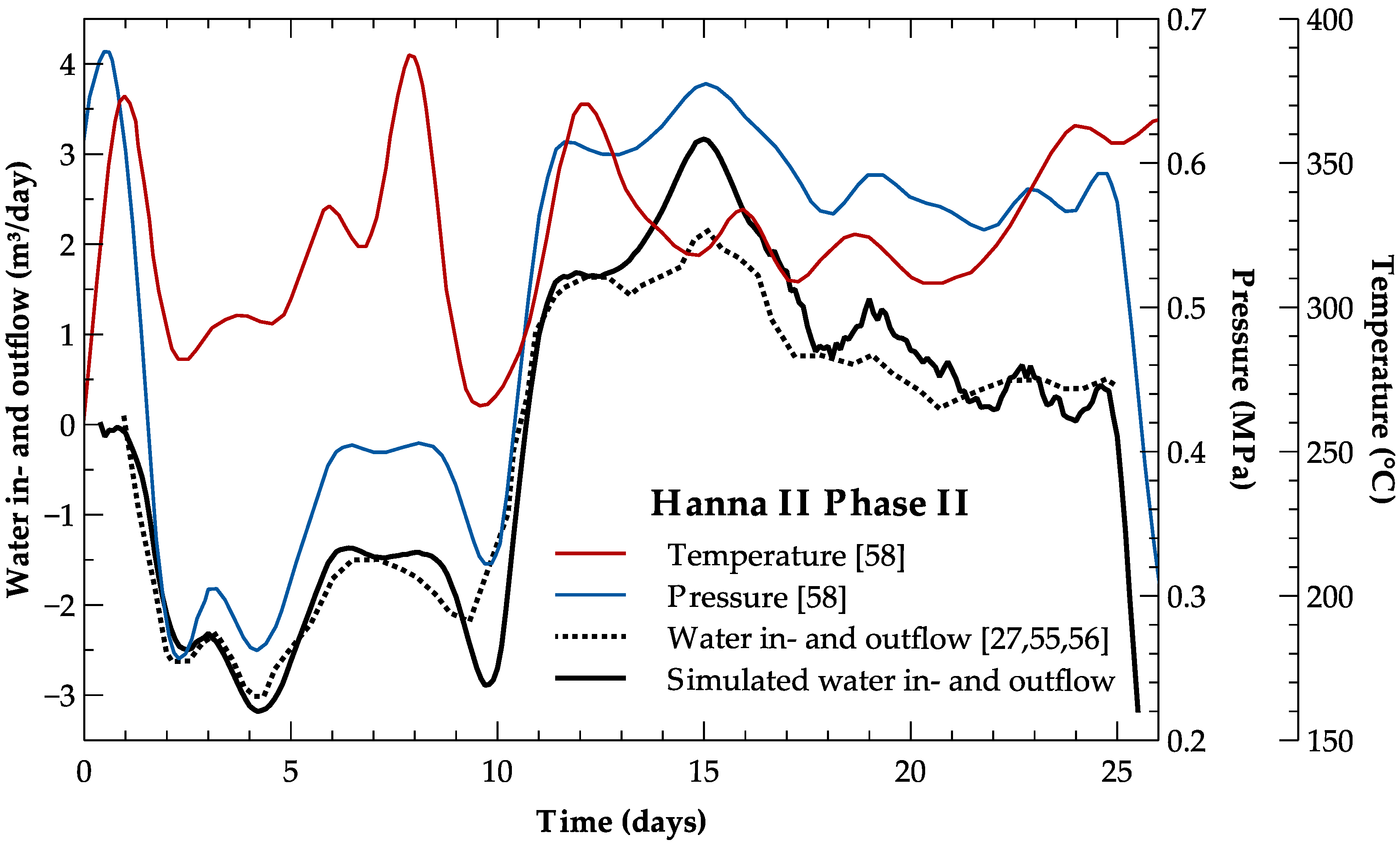
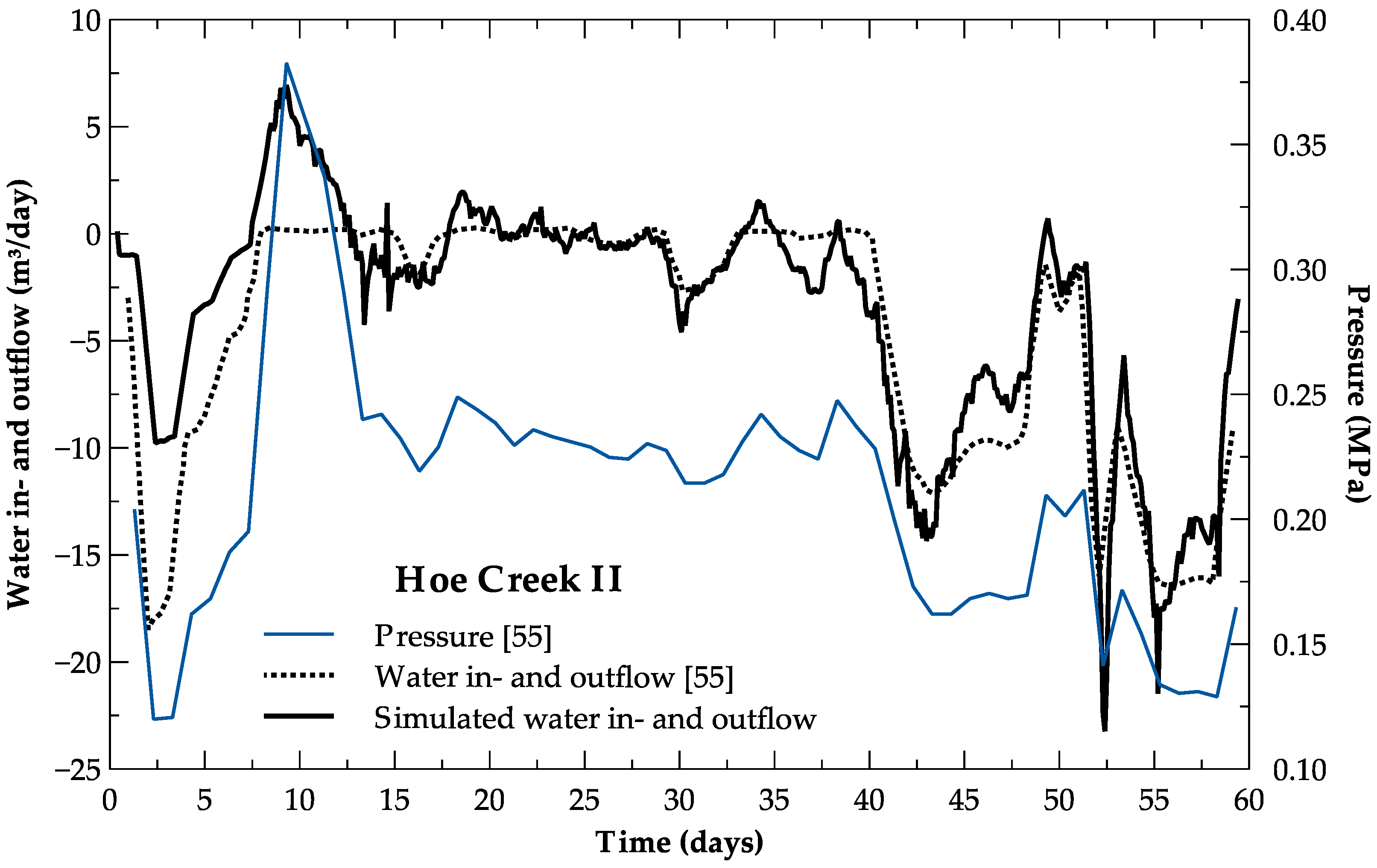

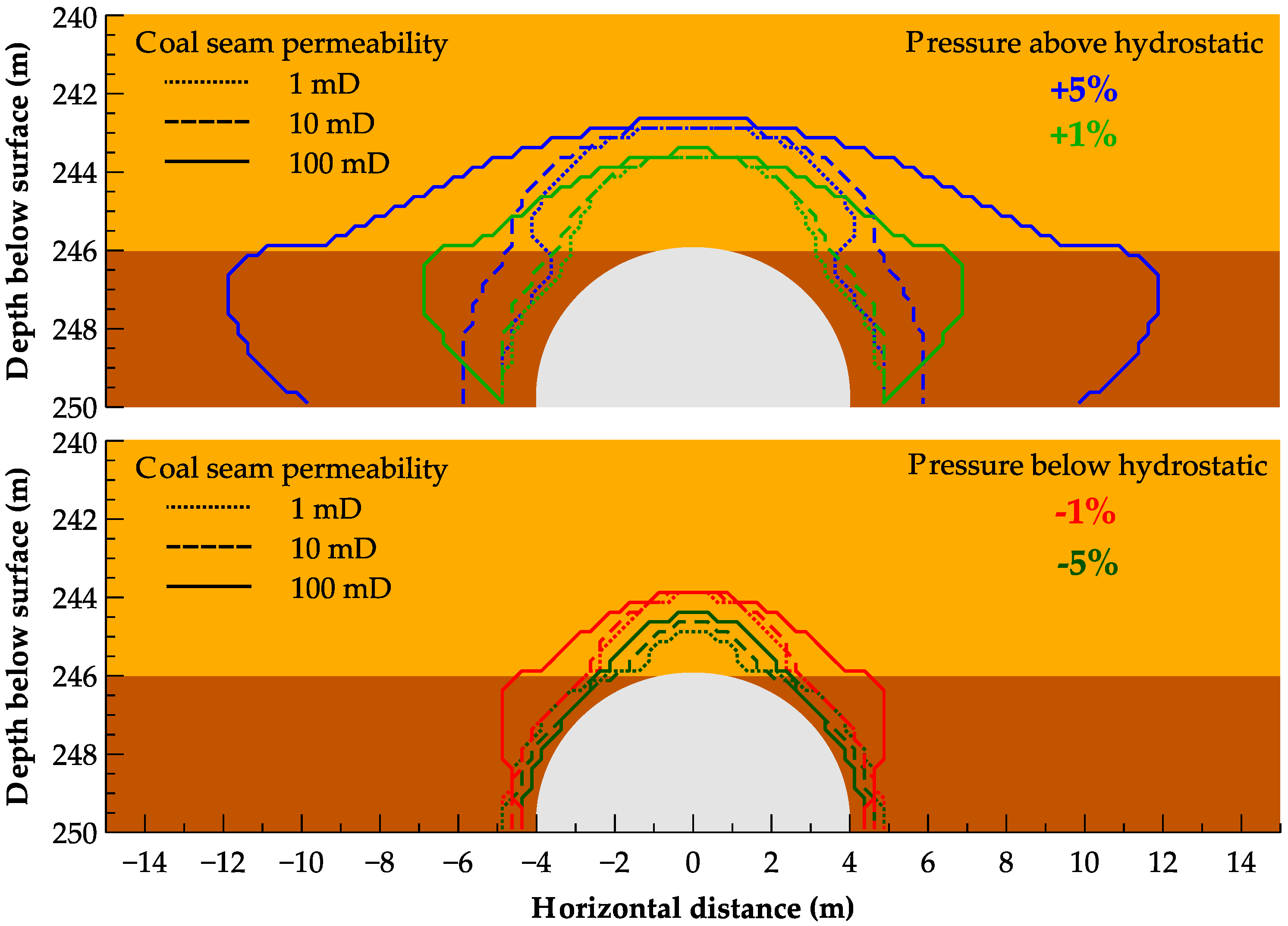
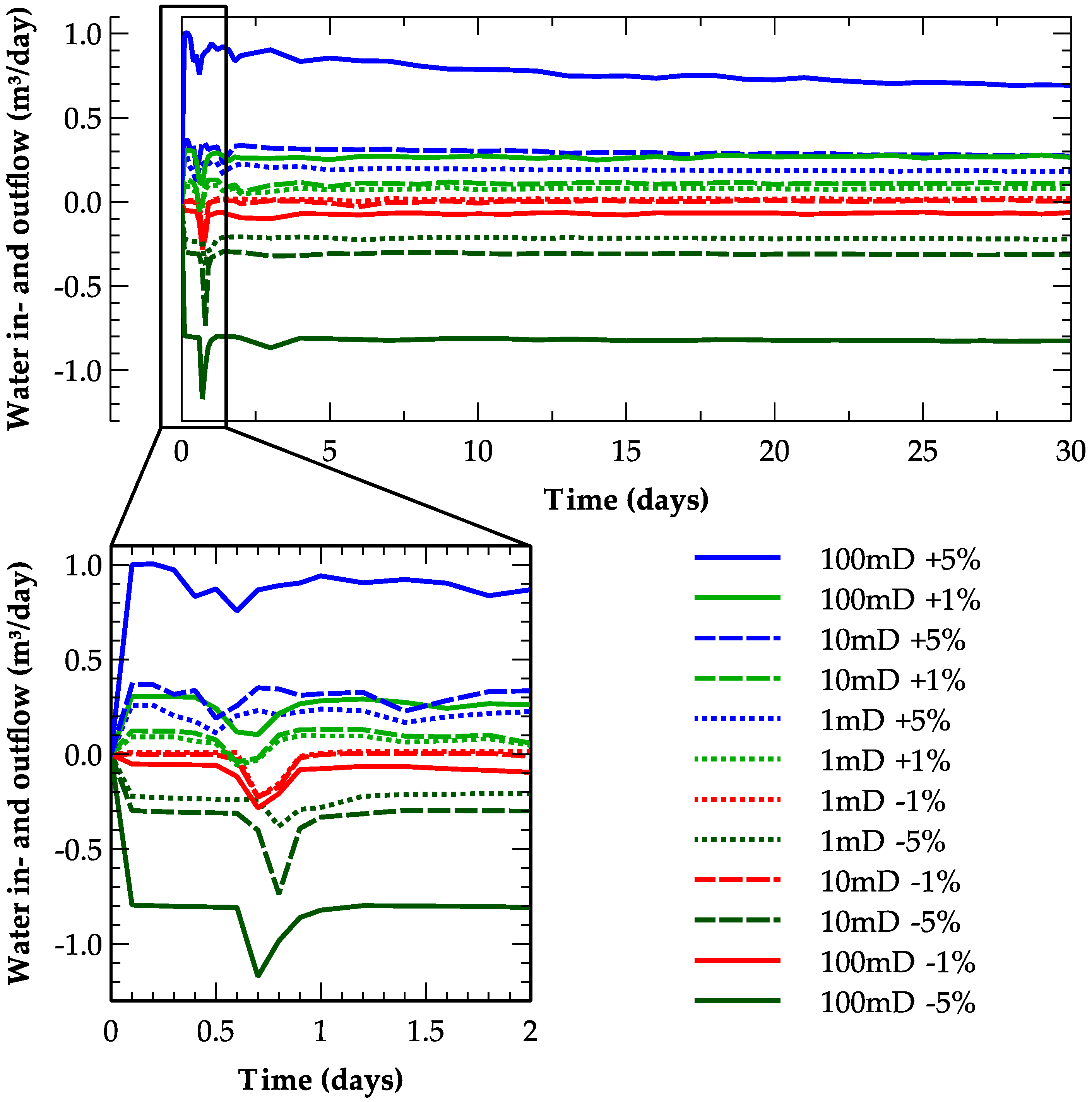
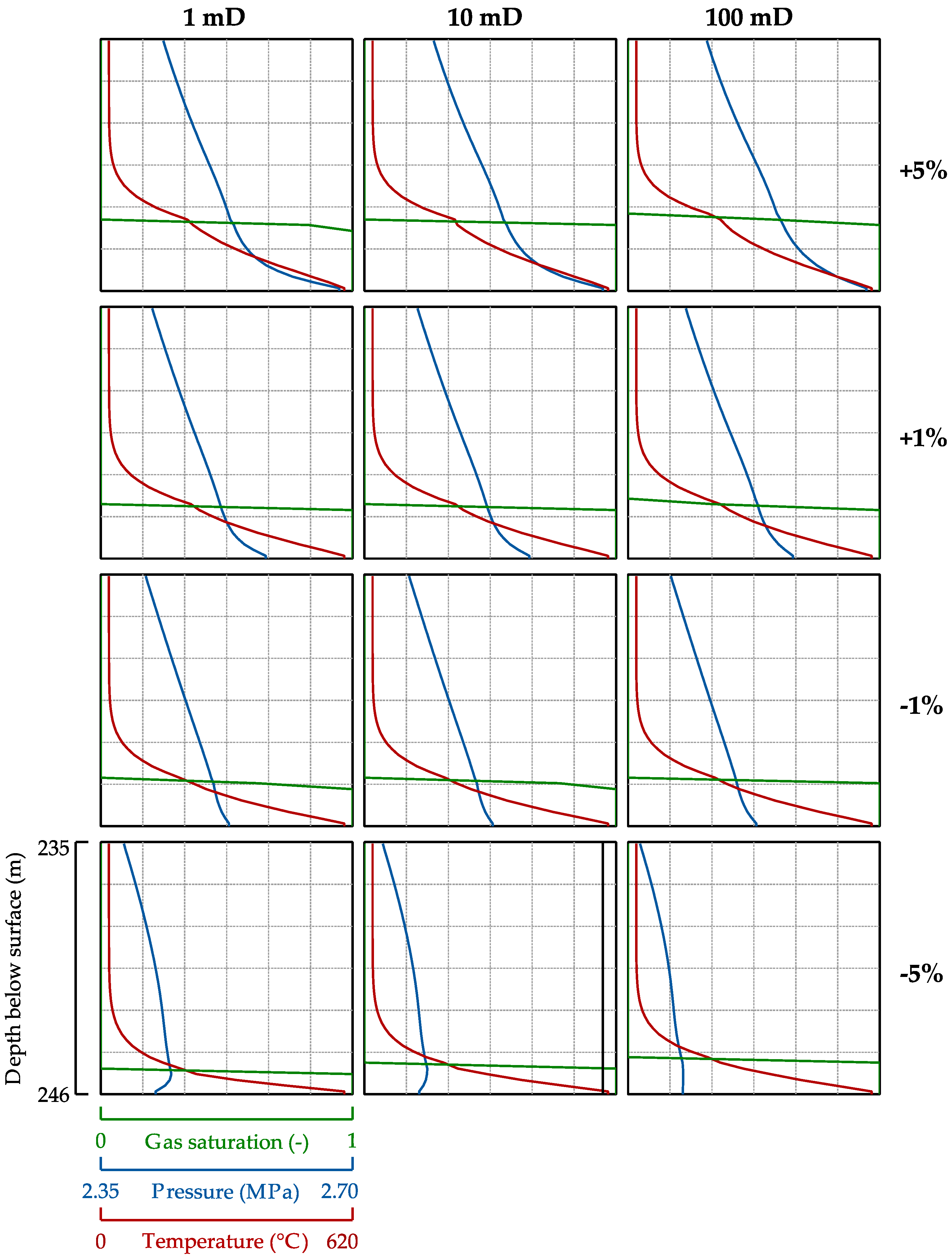
| Parameter | Hanna II | Hoe Creek II | ||
|---|---|---|---|---|
| Coal Seam | Overburden | Coal Seam | Overburden | |
| Density (kg/m3) | 1350 | 2200 | 1350 | 2259 |
| Specific heat capacity (J/kg K) | 2000 | 1636 | 800 | 900 |
| Thermal conductivity (W/m/K) | 3.4 | 2.0 | 0.27 | 2.0 |
| Porosity (-) | 0.1 | 0.1 | 0.1 | 0.1 |
| Horizontal permeability (mD) | 5 1 | 5 | 100 1 | 120 |
| Vertical-to-horizontal permeability ratio (-) | 1/3 | 1/3 | 1/5 | 1/5 |
| Parameter | Coal Seam | Overburden |
|---|---|---|
| Density (kg/m3) | 1300 | 2200 |
| Specific heat capacity (J/kg K) | 2000 | 1363 |
| Thermal conductivity (W/m/K) | 0.23 | 2.3 |
| Porosity (-) | 0.02 | 0.1 |
| Permeability (mD) | 1; 10; 100 1 | 50 |
| Horizontal-to-vertical permeability ratio (-) | 1/3 | 1/3 |
© 2017 by the authors. Licensee MDPI, Basel, Switzerland. This article is an open access article distributed under the terms and conditions of the Creative Commons Attribution (CC BY) license (http://creativecommons.org/licenses/by/4.0/).
Share and Cite
Otto, C.; Kempka, T. Prediction of Steam Jacket Dynamics and Water Balances in Underground Coal Gasification. Energies 2017, 10, 739. https://doi.org/10.3390/en10060739
Otto C, Kempka T. Prediction of Steam Jacket Dynamics and Water Balances in Underground Coal Gasification. Energies. 2017; 10(6):739. https://doi.org/10.3390/en10060739
Chicago/Turabian StyleOtto, Christopher, and Thomas Kempka. 2017. "Prediction of Steam Jacket Dynamics and Water Balances in Underground Coal Gasification" Energies 10, no. 6: 739. https://doi.org/10.3390/en10060739






